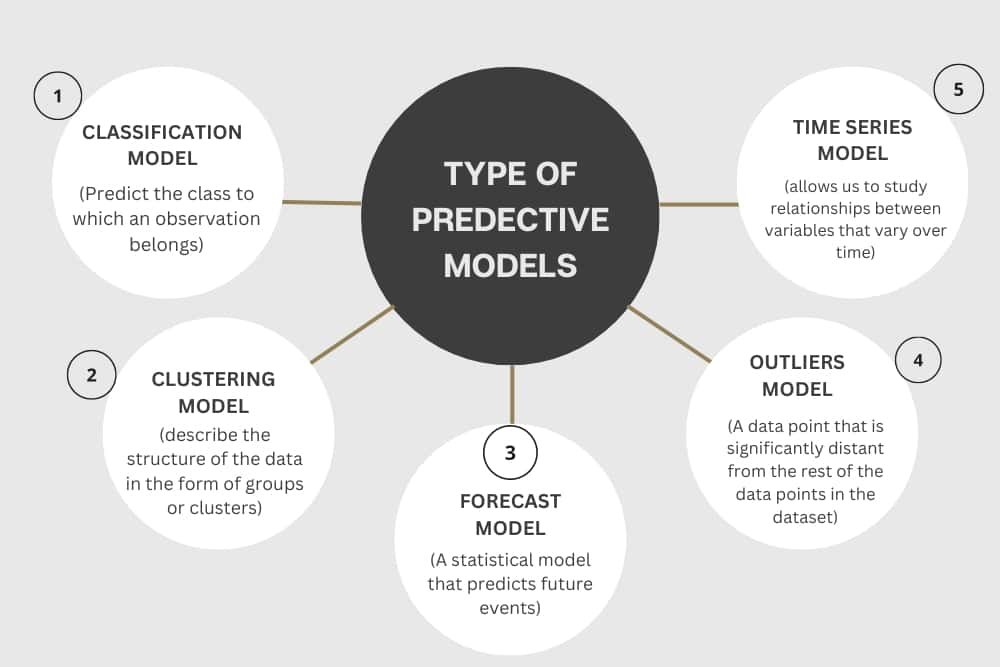Predictive modelling is a process that uses mathematical models to generate predictions about future events or behaviour. Predictive modelling is used in a variety of fields, including marketing, finance, and insurance. Predictive modelling can be used for both short-term and long-term predictions. Today’s blog on Predictive Modelling: Types, Benefits and Algorithms would take you on a journey in learning about predictive modelling, types of predictive modelling and the common algorithms it houses. You would also learn about the benefits that predictive modelling has in the 21st century. Let’s get started!
What is Predictive Modelling?
Predictive modeling is the application of statistical methods and machine learning to data to make predictions about future trends. Prediction model examples include- predicting customer churn, identifying fraudulent transactions, or forecasting product demand.
There are several effective uses of predictive modelling such as:
- Used in creating long-term and short-term forecasts as well as in making predictions about a wide variety of events, including customer behaviour, product purchases, stock prices, etc.
- Predictive modelling can be used to project sales revenue for a new product over the next four years and make decisions about pricing and marketing. It can also be used to predict patient outcomes and help doctors decide the best treatment for a particular patient.
- One of the most common uses of predictive modelling is in marketing. Marketers use predictive modeling to help predict which customers are most likely to respond to a particular marketing campaign. For example, a marketer might use predictive modeling to determine which customer segments will respond to a discount offer on a specific product.
- They can also use predictive modelling to determine the best time to send promotional emails to their customers in order to maximise the effectiveness of the campaign.
Types of Predictive Modelling
There are various types of predictive modelling techniques that are commonly used to make predictions about future events. The top 5 types of predictive models in Data Science are described below:
Classification Model
A classification model is used to predict the class to which an observation belongs. The observations are classified into multiple classes based on the response variable. The most common type of classification model is the decision tree model. In this model, the observations are classified according to a simple set of rules. These rules determine the class to which the observation belongs. A prediction model example for a classification model is a decision tree model. This is a popular model for classifying data and can also be used for making other types of predictions such as regression or clustering. It is one of the simplest and most widely used classification methods. It can be used for text classification, medical diagnosis, speech recognition, image recognition, financial data analysis, marketing analysis, and many other applications. For example:
- Grouping of pet animals by types such as cats, dogs, rodents etc.
- Classifying patients based on their medical history
- To identify high-risk patients that need extra attention.
- Classifying advertisements based on whether they are likely to be viewed
- To determine which ads are more likely to be clicked by users.
Clustering Model
A clustering model is used to describe the structure of the data in the form of groups or clusters. Each group is represented by one or more variables and consists of a number of observations. An example of a clustering model is the k-means clustering algorithm. This algorithm assigns each observation to the nearest cluster centroid. It utilises iterative rounds of partitioning of the data in order to generate distinct groups in the data. It can also be used for performing tasks such as market analysis or traffic analysis. For example:
- Determine the underlying structure of the market by analysing customer demographics and behaviours.
- Analyse data about traffic patterns to make recommendations to city planners about how to improve traffic flow.
- Cluster genes according to their functional similarity.
- Cluster countries based on their economic similarity.
Forecast Model
A forecast model is one of the types of predictive models in Data Science which is a statistical model that predicts future events. It can be used to predict future stock prices, weather patterns, election results, economic conditions, and so on. It can be used for a variety of applications including business forecasting and marketing planning. For example:
- Calculate the probability of a stock reaching a certain price in the next 6 months.
- Forecast the demand for a particular product in the future and make recommendations based on the results.
- Predict the likelihood of a candidate winning an election based on the number of votes he/she receives.
- Make predictions of future economic conditions based on the current level of economic activity and existing trends.
- Design marketing campaigns by identifying the best channels to reach the target audience.
Outliers Model
An outlier is one of the predictive analytics models which is a data point that is significantly distant from the rest of the data points in the dataset. One of the most common examples of an outlier is a person who wins the lottery but whose monthly income is below the poverty line. It can also be a child with a very low IQ or an employee who achieves amazing results despite working only part-time. Examples of outlier modelling include:
- Determining whether a unit test results fall within an acceptable range or not.
- Identifying the factors that lead to outliers in a distribution.
- Detecting the presence of hidden outliers that are difficult to predict.
- Identifying fraudulent transactions by examining transaction data.
- Analysing trends in demographic variables to identify populations at high risk of health complications.
- Identifying risk of fraud by analysing customer transaction data.
Time Series Model
The time series model as part of the predictive analytics models is an extension of the regression model that allows us to study relationships between variables that vary over time. The model treats each observation as a vector consisting of a set of independent variables and a vector representing the value of the dependent variable at the point in time under consideration. Its key features include the ability to capture changes in the values of the independent variables over time and the ability to handle missing data. Some common applications of this model include:
- Forecasting short-term fluctuations in a stock market index.
- Evaluating the impact of changes in prices on a sales forecast.
- Evaluating the impact of service outages on customer loyalty.
- Predicting the outcome of an upcoming election based on an analysis of past election results.
- Assessing the impact of long-term trends in exchange rates on trade patterns.
- Determining the effects of external factors such as an increase in the price of gasoline on the demand for automobiles.
Common Algorithms in Predictive Modelling
Machine Learning
The basic premise behind ML algorithms is that the model learns from data and does a better job of making predictions than a traditional model would. Machine Learning prediction models examples can be identified as an algorithm might be designed to identify the symptoms of diabetes by analysing data on patient records. As more data is analysed, the algorithm becomes increasingly accurate at identifying patients with the condition. Modern ML algorithms are able to identify complex patterns in large data sets and improve the performance of traditional statistical models. Also find answer to Does Machine Learning Require Coding? Some common ML algorithms used in predictive analytics include the following:
Linear Algorithms – These algorithms fit a straight line to data points in a scatter plot in order to estimate the value of a dependent or response variable given a vector of independent or predictor variables. Machine Learning prediction models examples for Linear Algorithms include regression (which is used to estimate the values of a continuous variable) and classification (which is used to categorise cases into groups).
Non-Linear Algorithms – These algorithms fit a function that represents a nonlinear relationship between predictor and response variables. Machine Learning prediction models examples for non-linear algorithms include splines and neural network models.
Deep Learning
Deep learning involves applying neural networks to process data and make predictions. Neural networks are composed of layers of processing nodes that receive input from the previous layer, process it, and produce output for the next layer. Deep learning networks have a number of layers ranging from the input layer to the output layer. Each node in the network processes the inputs it receives and produces a weighted sum of the outputs of all of its neighbouring nodes. The output of the neural network is then passed on to the output layer and transformed into a label or predicted value. Deep learning networks are able to learn patterns of association between independent variables and the dependent variables that would not be identified using other methods.
There are more algorithms in predictive modelling which includes:
- Random Forest- A type of supervised learning algorithm that uses an ensemble of decision trees to make predictions. The ensemble approach is more accurate than using a single tree due to diversity in the outcomes produced by multiple trees. The random forest method uses bootstrap sampling to construct a smaller set of trees from the original data set and uses these trees to make predictions.
- Generalised Linear Model for Two Values- This model is used to examine the relationship between two or more continuous variables and one categorical variable. The model assumes that there is a linear relationship between the categorical variables and their association with the continuous variables. Examples of categorical variables include gender, age, race and education level. Examples of continuous variables include height and weight.
- Gradient Boosted Model- A type of supervised learning algorithm that builds a series of decision trees to analyse a dataset and make predictions. Data is split into separate training sets and test sets so that the algorithm can be trained and tested independently. Once it has been trained, the algorithm can then be applied to make predictions on the test set. Trees are constructed using the training data by selecting a set of variables at each split that is most relevant to making a prediction for the training instances at that split.
- K-Means- This is a supervised learning algorithm that is used to identify clusters in a dataset based on a predefined number of clusters. Each cluster in the dataset is represented by a set of points that best represents each cluster’s characteristics. K-means works by taking a set of points from a dataset and finding the mean of each data point in the set. The mean of the data points is used as a new starting point for the algorithm and the procedure is continued until all of the data points have been assigned to the appropriate cluster.
- Prophet- This open-source library is used to perform machine learning tasks such as classification, regression, clustering and recommendation systems. It is used in time-series or forecast models where data is continually updated over time. An example of a time series model is a model that forecasts future sales based on past sales data.
Benefits of Predictive Modeling
In general, predictive modelling is the process of building a statistical model from data that is then used to make predictions about new data. This allows companies and other organisations to make more informed decisions. The benefits of predictive modelling are numerous and include the following:
- Allows organisations to make more accurate predictions about the future based on their past experience.
- Provides a better understanding of the underlying factors that drive an event (such as a product launch).
- Helps to improve business processes by providing valuable insights into potential weaknesses in the organisation’s existing processes.
- Identifies new opportunities for products and services by uncovering what customers are interested in and what features they would be willing to pay for.
- Enables the organisation to test different product and marketing scenarios to determine which is likely to provide the most value to its customers.
- Improves the decision-making process by ensuring that any decisions that are made by the organisation are based on objective data rather than guesswork.
- Helps the organisation to be more competitive by reducing its reliance on expensive human talent and other time-consuming decision-making processes.
To Sum Up!!
From the above post on Predictive Modelling: Types, Benefits, and Algorithms, it is understood that Predictive Modelling has several advantages in the business world; they include increased efficiency, better decision-making and reduced costs. Data-driven decision making is the key to creating a competitive advantage in a fast-changing business environment. If you are a Data Science enthusiast, you may want to indulge in Data Science course for teenagers or enrol yourself in some Data Science certification training to understand the concepts better. With the help of different types of predictive modelling like Machine Learning and Deep Learning, industries are being able to advance decision-making within organisations. Accordingly, developing your skills in Data Science and undertaking Data Science course syllabus would only help you excel in your career. Happy learning!











